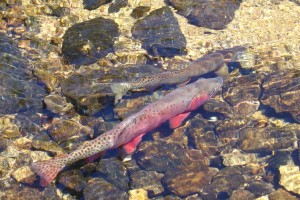By Elizabeth Russell Trout Unlimited is excited to announce Newmont Mining Corporation as a new and vital supporter of our Colorado Abandoned Mine Restoration Program. These historic mines and their legacy of toxic sediments and draining tunnels pose one of the most widespread—yet least addressed—threats to Western rivers and watersheds. By most estimates, more than 500,000 abandoned mines pollute 40 percent of headwater streams in the Western United States, and degrade over 14,000 miles of trout and salmon habitat.
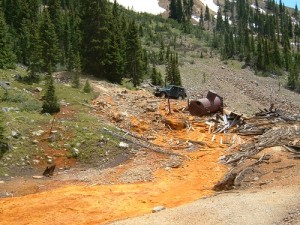 The estimated costs to clean up these sites range from $32-72 billion. Trout Unlimited initiated our Western Abandoned Hard Rock Mine Restoration Program in 2004 to both clean up problem mine sites that impact streams and fisheries, and to draw attention to the challenges associated with these efforts. From our innovative mine tailings revegetation projects addressing toxic mine tailings in Colorado to our successful floodplain restoration projects in Montana, Trout Unlimited has earned national recognition as the leading practitioner of Good Samaritan abandoned mine restoration in the country.
The estimated costs to clean up these sites range from $32-72 billion. Trout Unlimited initiated our Western Abandoned Hard Rock Mine Restoration Program in 2004 to both clean up problem mine sites that impact streams and fisheries, and to draw attention to the challenges associated with these efforts. From our innovative mine tailings revegetation projects addressing toxic mine tailings in Colorado to our successful floodplain restoration projects in Montana, Trout Unlimited has earned national recognition as the leading practitioner of Good Samaritan abandoned mine restoration in the country.
In Colorado, the problem of leaching mines is particularly prevalent and threatens the state’s most iconic rivers. The issue of water pollution stemming from abandoned mines burst into public consciousness when 3 million gallons of polluted heavy metal-laden water spilled into the Animas River from the Gold King Mine near Silverton, Colorado, in 2015. Although this spill was large-scale and devastating, thousands of similar mines leak that same orange polluted water in smaller amounts every minute of every day. Without cleanup action at each site, this will continue forever.
That’s where Trout Unlimited comes in. Our Colorado Abandoned Mine Restoration Program tackles cleanups by removing polluted waste and tailings from riparian areas, revegetating and stabilizing streambanks and natural stream channels, creating fish habitat, and improving water quality.
We are stopping the toxic legacy one watershed or river at a time.
It’s encouraging that some mining companies are stepping up to help address this problem. Newmont Mining Corporation is one of the largest mining companies in the world and owns the Cripple Creek and Victor Mine in Colorado.
Newmont has worked previously with Trout Unlimited and state and federal agencies to improve habitat for Lahontan Cutthroat Trout (LCT) in Nevada’s Maggie Creek basin. Changes in livestock grazing practices and other improvements in the Maggie Creek watershed have dramatically boosted stream and riparian habitat health throughout the basin, benefiting LCT populations.
“Newmont has recently expanded our North American operations into Colorado with the acquisition of the Cripple Creek and Victor mine,” said Newmont executive Steve Skidmore. “We look forward to our continued habitat restoration efforts in cooperation with Trout Unlimited in Colorado watersheds.”
Newmont Mining Corporation joins Freeport-McMoRan Inc., which owns the Henderson and Climax mines in the state, in supporting our program to improve water quality and fisheries in mining-impacted watersheds in Colorado. Giving back to the communities in which these companies operate is an important part of their commitment to the environment.
For TU, their support provides the critical funding needed to support our staff and project work. We look forward to showcasing our excellent cleanup projects in the near future.
Elizabeth Russell is manager of TU’s Colorado Abandoned Mine Restoration Program.






 Groups all over the state worked together to protect our state's water quality and our trout's quality of life. CTU hired water quality expert, Ashley Rust, as a consultant to provide technical support. Her work demonstrated flaws in the data selection and analysis used for the WQCD’s proposal. TU also worked with Colorado Parks and Wildlife scientists along with other organizations including Sierra Club, Colorado Wildlife Federation, CPW and EPA.
Groups all over the state worked together to protect our state's water quality and our trout's quality of life. CTU hired water quality expert, Ashley Rust, as a consultant to provide technical support. Her work demonstrated flaws in the data selection and analysis used for the WQCD’s proposal. TU also worked with Colorado Parks and Wildlife scientists along with other organizations including Sierra Club, Colorado Wildlife Federation, CPW and EPA.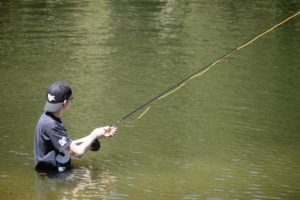 "Big thanks to John Woodling, who's testimony was a turning point in the hearing," said Whiting. "To Robin (Knox) who in 5 minutes conveyed a lifetime of experience- I loved the example of all the poor fish huddling in a small pool in the Yampa to avoid the hot water in response to the Division's callous assertion that if it's too hot, fish can just swim away. Big thanks to Dennis Buechler, who very softly and meekly brought in the impacts of these decisions on small businesses."
"Big thanks to John Woodling, who's testimony was a turning point in the hearing," said Whiting. "To Robin (Knox) who in 5 minutes conveyed a lifetime of experience- I loved the example of all the poor fish huddling in a small pool in the Yampa to avoid the hot water in response to the Division's callous assertion that if it's too hot, fish can just swim away. Big thanks to Dennis Buechler, who very softly and meekly brought in the impacts of these decisions on small businesses." The water from the Upper Colorado flows from Lake Granby (which acts as the storage facility), then it is is pumped into Shadow Mountain Reservoir where it then flows down into Grand Lake. From Grand Lake, the water then is pumped through the 13.1 mile long Alva B. Adams Tunnel under the Continental Divide and flows into the Big Thompson River. From there, the water drops into power plants that supply the pumps on the western slope.
The water from the Upper Colorado flows from Lake Granby (which acts as the storage facility), then it is is pumped into Shadow Mountain Reservoir where it then flows down into Grand Lake. From Grand Lake, the water then is pumped through the 13.1 mile long Alva B. Adams Tunnel under the Continental Divide and flows into the Big Thompson River. From there, the water drops into power plants that supply the pumps on the western slope.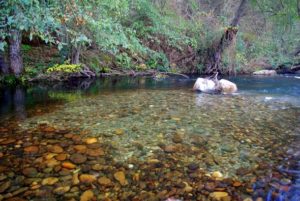 As the flows of the Upper Colorado are depleted by the diversion projects, the natural cleansing of the river fails to occur. Each spring, rivers experience flushing flows- an increase in water flow that breaks up sediment buildup along the stream bed. When the river isn't able to clean itself from sediment buildup between cobblestone, it doesn't allow for insects to hatch or fish to spawn.
As the flows of the Upper Colorado are depleted by the diversion projects, the natural cleansing of the river fails to occur. Each spring, rivers experience flushing flows- an increase in water flow that breaks up sediment buildup along the stream bed. When the river isn't able to clean itself from sediment buildup between cobblestone, it doesn't allow for insects to hatch or fish to spawn. The West needed water to expand. Currently, 80 percent of Colorado's population is on the east of the Divide while 80 percent of the water is on the west side. This means that in order to thrive, water needed to be diverted. The C-BT opened the door to other transmountain diversions- including the Moffat Tunnel from the Fraser River, another tributary of the Upper Colorado headwaters.
The West needed water to expand. Currently, 80 percent of Colorado's population is on the east of the Divide while 80 percent of the water is on the west side. This means that in order to thrive, water needed to be diverted. The C-BT opened the door to other transmountain diversions- including the Moffat Tunnel from the Fraser River, another tributary of the Upper Colorado headwaters.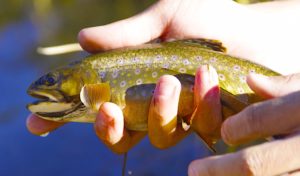 According to
According to 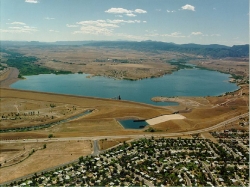 If not one who collects rainwater, another way to assist in the maintenance of healthy water levels is to pay close attention to sprinkler systems; making sure to turn off systems when it rains, and ensuring that they are only used a maximum of three times a week. These things are easy to do and are highly recommended by Denver Water in order to keep Colorado’s reservoirs in good shape.
If not one who collects rainwater, another way to assist in the maintenance of healthy water levels is to pay close attention to sprinkler systems; making sure to turn off systems when it rains, and ensuring that they are only used a maximum of three times a week. These things are easy to do and are highly recommended by Denver Water in order to keep Colorado’s reservoirs in good shape.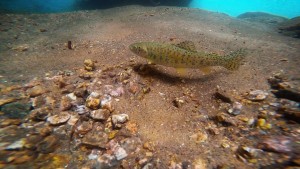 that would weaken the temperature standards that are supposed to protect trout streams throughout the state. The proposed changes brought forth by the Water Quality Control Division (WQCD) would put many trout fisheries at risk including during spawning periods.
that would weaken the temperature standards that are supposed to protect trout streams throughout the state. The proposed changes brought forth by the Water Quality Control Division (WQCD) would put many trout fisheries at risk including during spawning periods.
 Trout Unlimited is working to ensure that the temperatures of Colorado's streams remain at a healthy level for trout to survive. CTU has put together an
Trout Unlimited is working to ensure that the temperatures of Colorado's streams remain at a healthy level for trout to survive. CTU has put together an 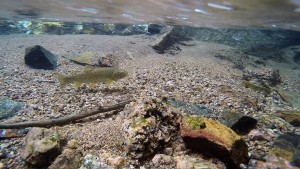
 Changes being proposed are potential, but the fish need our help. Trout Unlimited is conducting a
Changes being proposed are potential, but the fish need our help. Trout Unlimited is conducting a As the flows of the river are diverted and reduced, the water temperature could rise to a level threatening to trout and aquatic life- but with the 401 permit, these conditions will be monitored to ensure the fishery remains Gold. Also with lower flowers, the sediment and algae buildup cements between the cobblestone, preventing invertebrates to hatch and trout to spawn. By providing these flushing flows the sediment will be washed away and leave the cobblestone clear for aquatic habitat to survive.
As the flows of the river are diverted and reduced, the water temperature could rise to a level threatening to trout and aquatic life- but with the 401 permit, these conditions will be monitored to ensure the fishery remains Gold. Also with lower flowers, the sediment and algae buildup cements between the cobblestone, preventing invertebrates to hatch and trout to spawn. By providing these flushing flows the sediment will be washed away and leave the cobblestone clear for aquatic habitat to survive.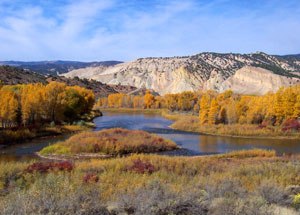 The decision comes after CPW has been monitoring unnatural stream flows, sparse aquatic habitat, and low nutrient content all contributed to the decline of the water. CPW said that stretch of the river hasn’t met the
The decision comes after CPW has been monitoring unnatural stream flows, sparse aquatic habitat, and low nutrient content all contributed to the decline of the water. CPW said that stretch of the river hasn’t met the 